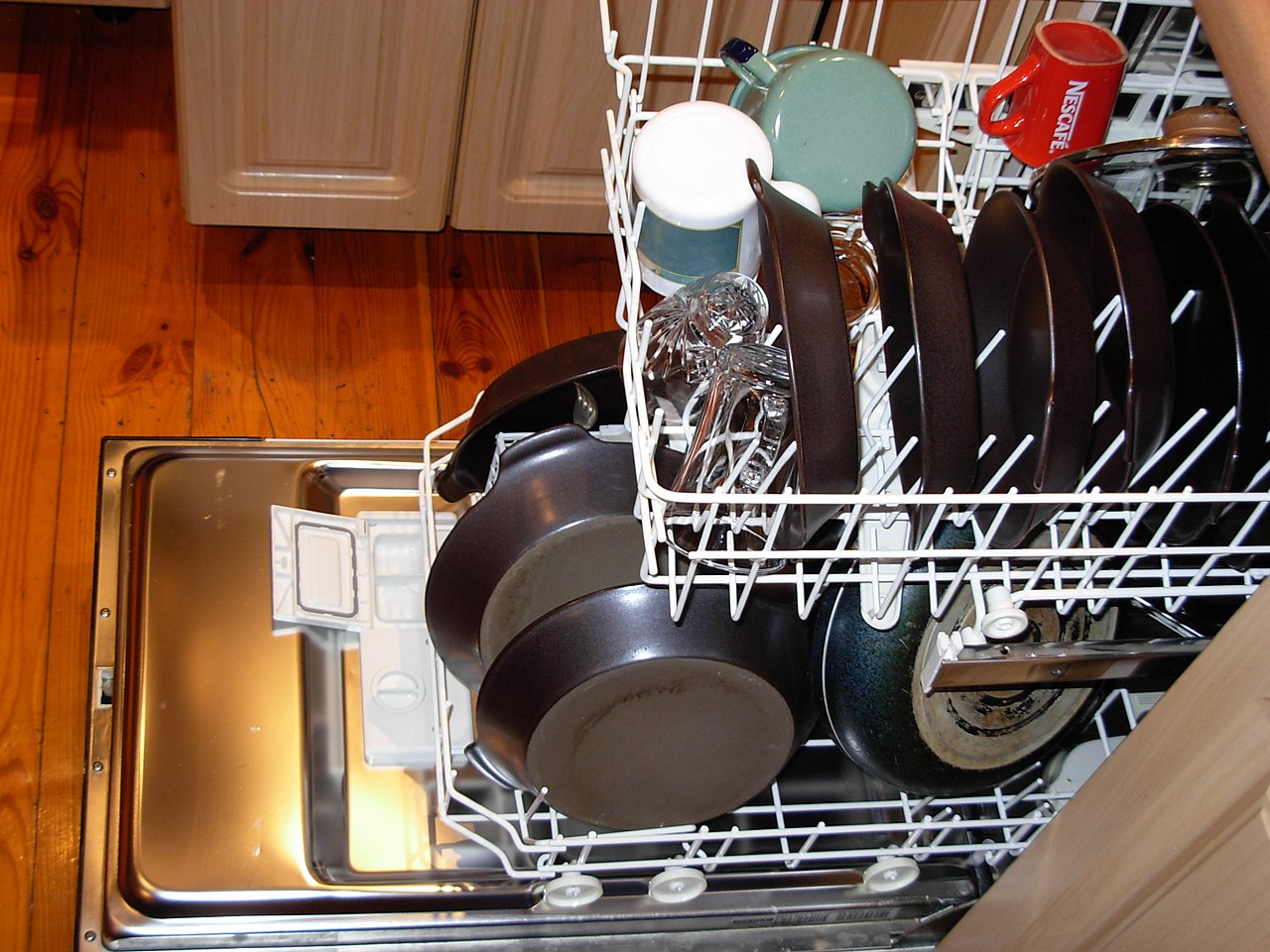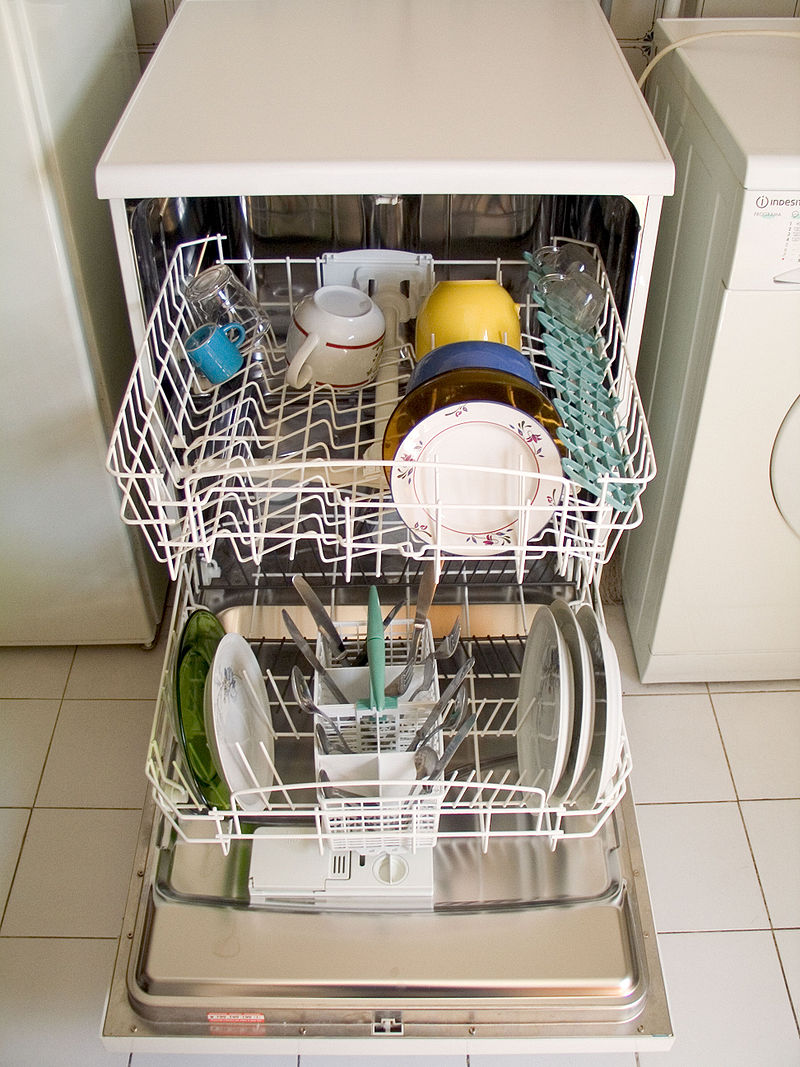A dishwasher is a reliable and automatic washing machine for dirty dishes, cookware, or cutlery. They are a good substitute for manual washing, especially for occasions at home where you may need loads of plates, utensils, and cookware.
Built-in Dishwashers
Built-in dishwashers are made to go under benches and typically do not come with sides or tops. Built-in dishwashers are advantageous in three ways: first, they are space-saving, especially for the countertop; second, they do not make loud noises as they are surrounded by cabinets in the kitchen; and third, they are convenient to operate given how near they are to where food is prepared in the kitchen. The downside about built-in dishwashers is that they are permanently installed, which means that you cannot just transfer them immediately when you decide to rearrange your appliances.
Portable Dishwashers
Portable dishwashers are also called freestanding dishwashers and are designed to be standalone units that can be positioned anywhere that has immediate access to water and drainage. The primary advantage of a portable dishwasher is that it can be moved and transferred wherever and whenever you like. It is a good option for people who have limited kitchen space or those that do not have built-in cabinets.
Drawer Dishwashers
Drawer dishwashers are characterized by their drawer-like doors. They can be pulled out like a drawer and have a discreet style. They are also convenient for the kitchen with smaller spaces and a smaller number of dishes. They can be either a one-drawer version or a double-drawer version.
Countertop Dishwasher
A countertop dishwasher is smaller in size compared to a portable dishwasher and has a lower capacity compared to all other types of dishwashers. This means that they are a perfect type to put on the counter and are suitable for families with a smaller number of members.
Integrated Dishwashers
Integrated dishwashers are built into your kitchen. They are not like a built-in dishwasher, which is only installed within cabinets, but rather is built into your countertop. This means that, depending on how it is designed, an integrated dishwasher can have a consistent appearance in your kitchen and can be hidden alongside cupboards and cabinets.
Commercial Dishwasher
A commercial dishwasher is the type of dishwasher used in businesses like restaurants, food stops, and hotels, that accumulates a larger number of dirty dishes in a day. Commercial dishwashers are far larger and work faster than all other types of dishwashers used at home.
Parts of a Dishwasher
Heating element
A heating element at the bottom of the dishwasher tank serves to raise the temperature in two specific cleaning instances: the first is during the washing cycle (to kill bacteria), and the second is during the drying cycle (to prevent moisture).
Racks
The racks of a dishwasher are vertical frameworks made of steel and coated with either polymer or nylon. Dishwashers are mostly made of three racks: the bottom rack is where you can place plates, pots, pans, and large bowls; the second upper rack is where you can place glasses, coffee cups, and uniquely styled utensils. The third silverware rack is for the placement of forks, knives, spoons, measuring spoons, and small utensils.
Spray arms
Spray arms are rotating arms located in both the upper rack and the bottom rack. They function as sprayers of water and activate when the water from the circulation pump pushes through into the arms.
Control pad
The control pad is the button that controls the function of a dishwasher. They are rectangular consoles mounted either on top of or in front of the dishwasher.
Detergent and rinse aid dispenser
The detergent and rinse aid dispensers are small chambers located next to each other. They should be stored before the cleaning and rinsing cycle.
Silverware basket
The silverware basket is a removable receptacle that is placed in the lower dishrack to hold smaller items such as lids and silverware. They can be repositioned if you need to make room for washing larger items in the dishwasher.
Water inlet valve
Located behind the lower kickplate panel in either the right or left corner of a dishwasher. It is responsible for controlling the amount of water used during the washing and rinsing cycle.
Circulation pump & motor
The circulation pump & water works hand-in-hand. The latter increases the water pressure while rotating, while the former is responsible for circulating and pumping water into the dishwasher tub through the spray arms.
Filtration System
The filter system is located under the lower basket of the dishwasher. They prevent the pump from clogging with large amounts of food residue and filter dirty water.
Door latch
The latch securely closes the dishwasher door. A latch under the inner door plastic cover toggles a safety switch, telling the dishwasher that the door is closed and allowing it to start the cycle.
How does a dishwasher operate?
Filling
The first stage of how a dishwasher operates is by filling first the correct amount of water to wash the dish. Filling the water begins by actually first draining water from the appliance to discharge any excess or remaining liquid in the machine. Once there is no more excess water, a timed fill cycle enters the dishwasher which then supplies it with not more nor less than two gallons of water. The timed fill cycle makes sure that there is no overfilling or underfilling of water, for the second stage to function properly.
Washing
After the proper amount of water is supplied to the dishwasher, the washing stage begins. Three factors must be present for the washing stage to perform properly: the temperature, the detergent, and the water circulation. The washing stage begins with the water going through the hot element and producing hot water.
The pump which uses an impeller forces the water up which is now cooler to the spray arms and sprays water on the dirty dishes. Once the food debris is washed off the dishes, it is collected in the sump, which filters and prevents larger particles from clogging the wash arms. As the water circulates through the arms, the detergent dispenser opens and releases the detergent to mix with the water. Throughout the washing cycle, the heating element continues to use hot water that goes cooler up to the wash arms and is sprayed onto the dishes.
Draining
After completing the wash cycle, the dishwasher will drain the dirty water from the tub by using an impeller that forces the water through the drain hose and disposal pipe.
Rinsing
Again, the dishwasher will undergo many rinse cycles similar to the wash cycle and may also use the heating element throughout the cycle. The final rinse, will open again the dispenser and dispense a rinse aid which helps the dishware to dry faster and prevent streaking. After the final rinse, the drain cycle will follow which now drains the water. Some water will remain in the tub to preserve the seals and prevent cracking which is then drained when starting another washing batch.
Drying
The last stage is the drying process which uses heat and venting. Heat element heats the air inside the tub which then goes through the vent to avoid creating moisture to the dishes.
What to consider when choosing a dishwasher?
Price
A dishwasher’s price starts at $500 with the most basic features. The most expensive can reach up to $1,200 or more with fancy features such as a quicker washing and drying cycle and less operating noise. No matter the price of the dishwasher you have, a $500 dishwasher will still be able to wash your dirty dishes. But if you have a specific feature you are looking for or would like to avail yourself of the best quality with more comfort features, then you should be looking for a much more expensive dishwasher.
Cleaning Cycle
The cleaning cycle is an important factor when choosing a dishwasher. The price is not the ultimate determiner of a quality dishwasher, you also need to make sure that the overall cleaning cycle functions properly and the best. A dishwasher with the best cleaning cycle means spotless, clean, dry dishes; no under or overfilled water; and washing in the quickest yet gentlest manner.
Noise
Dishwashers tend to have a noisy operating process, specifically a grinding or buzzing sound when it forces water down the drain. Higher quality dishwashers however will offer you lesser noise compared to other types.
Efficiency
A good quality dishwasher should be efficient and easy to use. As much as possible, it should give more comfort to household owners while also considering the amount of energy it can provide.
Capacity
The capacity of a dishwasher is also one of the most important things as it should be able to wash more dishes as possible in the fastest way possible.
Stainless Steel Tub Dishwasher Vs. Plastic Tub Dishwasher
Stainless and plastic are common tub materials used in dishwashers. The tub refers to the interior material that holds the rack together inside. Here are a few differences between the two:
Stainless Dishwasher:
- Quieter system
- Runs at a higher temperature which is good for deep-washing
- Can withstand higher temperature
- Durable
- Better cleaning
- Energy-Efficient
- More Cycle Options
- Longer-lasting Life Span
Plastic Dishwashers:
- Budget Friendly
- Rust-free
- Smooth design
- Lightweight
- Stain-resistant
Other things that can be wash in a dishwasher
A dishwasher can also be used for washing different things aside from cookware and dishware. The ultimate reminder when washing other items in the dishwasher is to make sure that they are placed in areas where they will fit and can be cleaned best. For example, thin and small things such as toothbrushes or hairbrushes should be placed in the utensil holder; plastic things such as toys or a pet’s toy can be placed in the dishwashing racks, larger items such as car parts or refrigerator shelves should be placed in the bottom racks.
Another tip that you should remember is to make sure that the items you plan to wash in the dishwasher are not breakable or will not damage the material of the item. For example, if you are planning an item made of cloth, ensure that they are not made of canvas or mesh. Also, if you are aware that the item will melt, avoid washing the material at a higher temperature. Lastly, and the most important reminder is to never wash items together with your dishware, cookware, and utensils. Here is a list of the few items you can wash in a dishwasher:
- Plastic toys, plastic hairbrushes and makeup brushes, plastic hair accessories
- Toothbrush, toothbrush holders
- Kitchen tools such as dish racks, dish sponges, dish brushes, refrigerator shelves, stove, and grill grates
- Garden tools
- Plastic or rubber dog toys
- Rubber shoes
- Bathtub mats, silicone oven mitts,
Final Thoughts
A dishwasher is a convenient technology that has made dishwashing easy and comfortable. Different types of dishwashers suit every household’s preferences and needs. Aside from the typical use of a dishwasher, it is also a convenient way to wash several items for comfort and quick washing.



